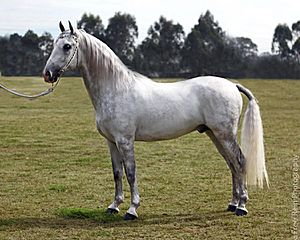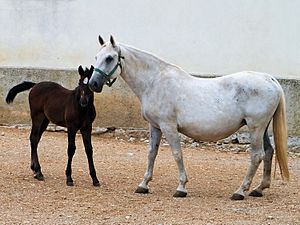Lipizzaner facts for kids
The Lipizzan or Lipizzaner is a beautiful grey horse breed. These horses are famous for their amazing performances in Dressage, a type of horse riding where horses perform graceful, ballet-like movements. They are often seen at the famous Spanish Riding School in Vienna, Austria.

A modern Lipizzan
|
|
| Distinguishing features | Compact, muscular, generally associated with the Spanish Riding School |
|---|---|
| Alternative names | Lipizzaner, Karster |
| Country of origin | Developed by the House of Habsburg from Arab, Barb, Spanish and Neapolitan stock. Today associated with nations of Austria, Hungary, Slovenia and Croatia. |
| Breed standards | |
| Verband der Lipizzanerzüchter in Österreich | Breed standards |
| Lipica Stud, Slovenia | Breed standards |
| Ministero delle Politiche Agricole e Forestali, Italy | Breed standards |
| Lipizzaner Society of Great Britain | Breed standards |
| Lipizzan International Federation | Breed standards |
| Lipizzan Association of North America | Breed standards |
| Horse (Equus ferus caballus) | |
Contents
What Makes Lipizzans Special?
Most Lipizzans are about 15 to 16 hands tall. (A hand is a unit of measurement for horses, equal to 4 inches or about 10 centimeters). Some older types of Lipizzans, originally bred for pulling carriages, can be a bit taller, around 16.1 hands.
Lipizzans have a unique look. They have a long head with a straight or slightly curved nose. Their eyes are large and expressive, and their ears are small. They have a strong, arched neck and broad shoulders. They are known as a "Baroque-type" horse, which means they have a powerful, rounded body, a wide chest, and strong muscles. Their tail is carried high. Their legs are strong with clear tendons, and their feet are tough, even if they seem small.
Lipizzan horses grow up slowly. However, they live and stay active longer than many other horse breeds. Some Lipizzans perform difficult exercises at the Spanish Riding School well into their 20s and can live into their 30s.
The Color of Lipizzans
Most Lipizzans are gray. You might see a rare solid-colored Lipizzan, usually bay or black. Like all gray horses, Lipizzans have black skin and dark eyes. As adult horses, their hair coat turns white.
Gray horses, including Lipizzans, are born with a dark coat, usually bay or black. They become lighter each year as their hair turns white. This process is usually finished when they are between 6 and 10 years old. It's a common mistake to think Lipizzans are true white horses. A true white horse is born white and has unpigmented skin.
Before the 18th century, Lipizzans came in other colors too. These included dun, bay, chestnut, black, piebald (white with large black patches), and skewbald (white with large brown or reddish patches).
History of the Lipizzan Horse
The Lipizzan breed began in the late 1500s. It was developed by the House of Habsburg, a powerful royal family in Europe. They wanted to create a strong, elegant horse for riding and pulling carriages.
The breed was named after the Lipica stud farm, which is now in Slovenia. This farm was founded in 1580. The Lipizzan horses were created by mixing different horse breeds. These included Spanish, Neapolitan, Arabian, and Barbary horses. These breeds were known for their strength, beauty, and intelligence.
The Lipizzans became famous for their use in classical Dressage and for their connection to the Spanish Riding School in Vienna, Austria. This school has been training Lipizzans for centuries to perform amazing, ballet-like movements.
Images for kids
-
Lipizzan stallion, Schönbrunn Palace
-
Lipik Stud, Croatia
-
Lipica stud farm, Slovenia
See also
 In Spanish: Lipizzano para niños
In Spanish: Lipizzano para niños









